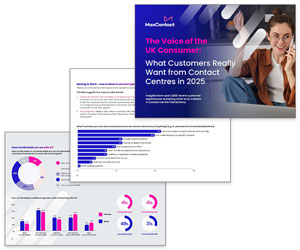Public sector contact centres are on the cusp of a digital revolution, aiming to streamline processes, personalise interactions, and delight customers with efficient and user-friendly experiences.
However, embarking on this journey often comes with budgetary limitations. While long-term digital goals are crucial, the needs of your contact centre can’t wait. In this blog post, we’ll explore practical strategies to bridge the gap between your current state and digital goals.
Public Sector Budgets & ROI for 2024
The local government finance settlement for 2024-25 makes £64.7 billion available for local government, a 7.5% increase.
The Government promises £4.2 billion in funding in 2024, allowing UK public services to invest in new technologies like AI and replace outdated IT systems.
However, a study by the Department for Levelling Up Housing and Communities showed that councils dedicate only around 15% of their digital budgets to transformation initiatives, with legacy system maintenance consuming resources.
The study also revealed good progress towards digital transformation, with nearly three-quarters of responding councils having an identified technology leader and over half having a published digital strategy.
However, budget pressures can hinder upgrading legacy systems, which are often less secure and efficient than modern varieties. On average, 15% of councils’ digital budgets are spent maintaining legacy technology, a figure that should ideally be reduced to zero.
Despite these challenges, studies suggest significant potential for cost savings and improved efficiency through digital tools, with examples of over £41 million in direct savings showcased by the Local Government Association.
The public also benefits from faster, more convenient services, while improved data management informs better decision-making. The pandemic accelerated progress by an estimated five years, suggesting some projects can be completed relatively quickly.
Assessing Your Current Landscape
Before tackling solutions, assess your current landscape to prioritise the most impactful initiatives:
- What are the biggest pain points for your customer-facing teams and customers?
- Are there recurring issues with call handling, call waiting, self-service, or team training?
- Envision your ideal state and how technology could empower your team to deliver excellent service.
Practical Interim Solutions
- Migrate to a cloud-based contact centre platform for more flexibility, control over costs, and regular enhancements. Bring all customer interactions into one platform for easier, more efficient management.
- Consider workforce management and optimisation tools for automated scheduling, performance tracking, and skills-based routing. Ensure you have the right team with the right skills to handle calls at the right times to improve efficiency and decrease wait times.
- Refine your IVR menus and route calls automatically to the best people. Explore natural language processing for smarter call routing. A well-designed IVR empowers customers to self-serve while reducing the burden on your agents.
- Create digital self-service opportunities, like a robust knowledge base accessible to agents and the public. Build out FAQs, guides, and resources. When agents can quickly find answers and customers can easily help themselves, everyone benefits.
- Use AI-driven insights from tools like speech analytics to coach and develop your team. Invest in targeted training to address skill gaps. Motivated, well-equipped agents are the backbone of great public service.
- Implement omnichannel communication, allowing customers to interact via webchat, email, or social media for increased convenience and satisfaction.
- Utilise SMS or email notifications to keep customers informed about appointments, application statuses, or service updates, demonstrating transparency and enhancing the customer experience.
- Gather customer feedback after every interaction through post-call surveys or email feedback forms. Analyse this feedback to identify areas for improvement and contribute to your long-term digital transformation strategy.
Remember the Big Picture
As you implement interim solutions, view them as stepping stones in your larger transformation journey.
Define clear metrics to measure success, develop a change management plan to support adoption, and consistently analyse data to surface ongoing improvement opportunities.
Maximise the impact of interim solutions by focusing on measurable outcomes, implementing a change management strategy for smooth adoption, and leveraging data analytics for continuous improvement.
These insights can inform both your current operations and your long-term digital transformation goals.
The path to digital transformation is challenging, but with pragmatic strategies, public sector contact centres can make strides even with constrained budgets.
By focusing on cloud migration, workforce optimisation, self-service enhancements, agent empowerment, omnichannel communication, and data-driven continuous improvement, you can bridge the digital gap and lay a strong foundation for the future.
Embrace the journey and celebrate each milestone – your team and the public will thank you.
Sources:
- https://dluhcdigital.blog.gov.uk/2023/09/28/local-digital-evaluation-study-a-snapshot-of-our-initial-findings/
- https://www.local.gov.uk/digital-transformation-programme
- https://www.virginmediabusiness.co.uk/revolutionise-the-everyday/local-authorities/
This blog post has been re-published by kind permission of MaxContact – View the Original Article
For more information about MaxContact - visit the MaxContact Website
Call Centre Helper is not responsible for the content of these guest blog posts. The opinions expressed in this article are those of the author, and do not necessarily reflect those of Call Centre Helper.
Author: MaxContact
Published On: 7th May 2024 - Last modified: 6th Dec 2024
Read more about - Guest Blogs, MaxContact






 MaxContact is the AI-powered customer engagement software that helps you turn every customer conversation into a high-impact, revenue-driving moment. We empower your teams to connect smarter, perform better, and scale faster – without losing the human touch.
MaxContact is the AI-powered customer engagement software that helps you turn every customer conversation into a high-impact, revenue-driving moment. We empower your teams to connect smarter, perform better, and scale faster – without losing the human touch. 










